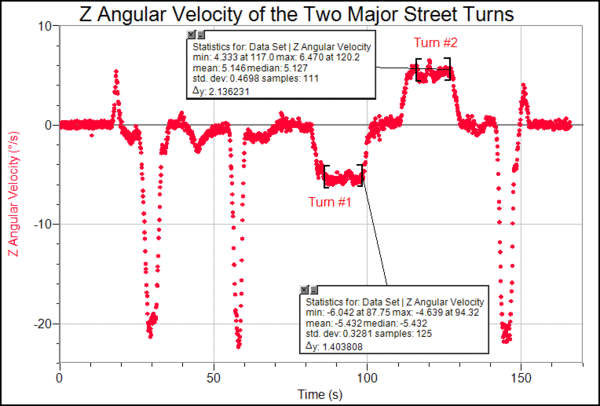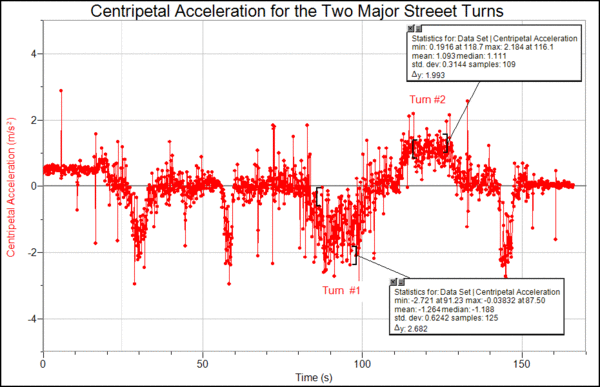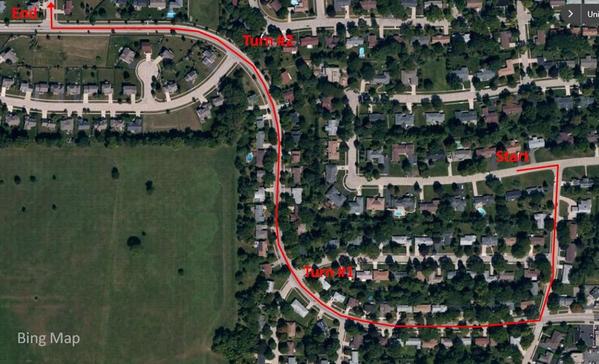This lesson is a physics application of PocketLab that allows students to determine the radius of curvature of a gradual turn on a street. A PocketLab mounted on the dashboard of a car records both the angular velocity and the centripetal acceleration of the car as it moves at a nearly constant speed around the curve. All of the required data for an example problem are contained in files attached to this lesson. Alternately, students can collect their own data. If the latter approach is used, students should be cautioned to be safe: (1) follow all speed limits and traffic laws, and (2) have one person drive while another works with the PocketLab app.
The photos below give two views of PocketLab mounted on the dashboard of a car using double stick mounting tape. The photo on the left shows that PocketLab has been mounted in such a way that it is level when the car is at rest on a level surface (in this case, the floor of a garage). The photo on the right shows that PocketLab has been mounted so that the Z-axis provides the angular acceleration as the car moves in the XY plane. Similarly, the Y-acceleration would then provide the magnitude of the centripetal acceleration as the car negotiates a turn on the street.

Below is a Bing map aerial view of the route (shown in red) driven by the car in the example problem of this lesson. The start and end of the route are shown. In addition the two major turns of interet are specified. Turn #1 is a gradual right turn, and it is followed by a similar gradual left turn, turn #2. These are the two turns whose radius we are interested in determining.

To get more of a feel for the actual ride, the video below was taken for this example. It is instructive to follow the video while viewing the Bing map. There are two initial sharp right turns at intersections, followed by a speed bump on the road, followed by turn #1, followed by another speed bump, followed by turn #2, followed by another speed bump, followed by a final right turn and stop onto a neighborhood street. Again, turn #1 and turn #2 are the turns of interest, i.e., the turns whose radii are to be determined.
The graph below contains a detailed look at the data collected for the Z angular velocity of the car. The three sharp right turns at intersections all have maximum angular velocity magnitudes of about 20 deg/s. The data for turn #1 and turn #2 have been identified on the graph. As there is some variation in the data, it is helpful to determine the mean angular velocity for each of the turns. Vernier Software & Technology (vernier.com) has an excellent educational data analysis software called Logger Pro that was used to determine the means, shown on the graph. Alternately, means could be calculated using a spreadsheet package such as Microsoft Excel. The mean magnitude for the angular velocity is 5.432 deg/s for turn #1 and 5.146 deg/s for turn #2.

The graph below contains a detailed look at the data collected for the Y acceleration (centripetal acceleration) of the car. There is significant variation of the data, so it is again necessary to compute means for turn #1 and turn #2. These turns have been identified on the graph, and coincide in time (86 to 98 seconds for turn #1, and 116 to 127 seconds for turn #2) with the angular velocities from the previous graph. The mean magnitude of centripetal acceleration for turn #1 is 1.264 m/s/s and for turn #2 is 1.093 m/s/s.

Attached is a pdf file for the teacher that shows the calculations for radii of turn #1 and turn #2. The radii turn out to be 141 m and 135.5 m, respectivel, for the turns. These are in good agreement with values that can be obtained from Bing or Google maps, when making use of the scale provided on these maps.

